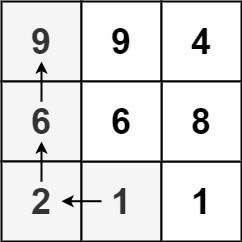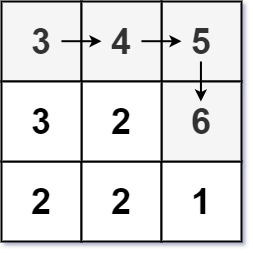Given an
From each cell, you can either move in four directions: left, right, up, or down. You may not move diagonally or move outside the boundary (i.e., wrap-around is not allowed).
Example 1:

Input: matrix = [[9,9,4],[6,6,8],[2,1,1]] Output: 4 Explanation: The longest increasing path is[1, 2, 6, 9] .
Example 2:

Input: matrix = [[3,4,5],[3,2,6],[2,2,1]] Output: 4 Explanation: The longest increasing path is[3, 4, 5, 6] . Moving diagonally is not allowed.
Example 3:
Input: matrix = [[1]] Output: 1
Constraints:
m == matrix.length n == matrix[i].length 1 <= m, n <= 200 0 <= matrix[i][j] <= 231 - 1
Solution
這題直覺想到用 DFS 來做,但是會TLE,所以要加速一下
這次要使用一個 DP 來加速,dp[i][j] 表示從 matrix[i][j] 出發的最大長度
所以在 DFS 的過程當中,如果 dp[i][j] 值已經不是初始的 0,那就直接回傳該值就好
kotlin
沒有留言:
張貼留言